The Origins of Palestine (Facts and Fiction)
December 2023 Newsletter 3
The Origins of Palestine (Facts and Fiction)
Tis the Season, when for centuries, Christians have wished each other “Peace on Earth and Goodwill to Mankind”. But this year world peace appears a distant hope, reminding us of Jeremiah 6:14 … ‘Peace, peace,’ they say, when there is no peace. Jeremiah wrote these words relating to the Babylonian siege on Jerusalem 2600 years ago. Today Israel once again finds herself under siege and her adversary now call themselves Palestinians. But where did the Palestinians come from in history and who are they really?
To answer this question, we need to go back in history to the origination of this present-day conflict which began in the womb of Isaac’s wife, Rebekah, who was pregnant with twin sons, Jacob and Esau, embattled within her womb (Genesis 25:22-24). Once born the adversarial conflict would continue over their inherited birthrights. A conflict that continues today over the perceived inheritance promises made by God, to their Grandfather Abraham. God would change Jacob’s name to Israel and a disgruntled Esau would leave the family to join his Uncle Ishmael and become the father of the Edomites of Edom, a region south of the Dead Sea. The Ishmaelites were settled further south of Edom in the region of Arabia.
First, we will identify where the term Palestine originated. Herodotus was a Greek historian who lived in the 4th century BC (often referred to as the Father of History). He was the first to use the term ‘Palestine’ in reference to a small strip of Mediterranean coastal land in the southern portion of the land of Judea held by the Philistines whom the Israelites never fully conquered. This was the origination of the geographical term ‘Palestine’, but the term was never used again until AD 132. The Philistine ethnic group was eliminated by Nebuchadnezzar during the Babylonian conquests of the region around 600 BC. During the Persian, Grecian, and Roman Empires the region of Israel was called Judea. After the last Jewish revolt in AD 132, Roman Emperor Hadrian, renamed the Roman provincial region of Judea, Syria Palaestina (or Palaestina for short). The Romans named the region after the Jewish people’s ancient arch-enemies of the Philistines and Moabites who were called Syrians at the time. There weren’t any known ethnic Philistines inhabiting the region. The Romans simply intended the name as an insulting rub against the Jewish people who had given the Romans so much grief. So, who were the inhabitants, ethnically speaking?

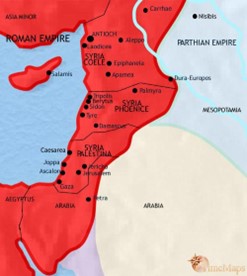
Region before Babylonian Invasion Emperor Hadrian established Syria Palaestina
The ethnic tribe called the Nabataeans (originally of Nabatu Tribes) lived in the stone fortresses of Petra (located in southern Jordan today). In the 2nd century BC, the Nabataeans expanded their regional control into the tribal regions of Edom and Moab, as the Greek Seleucid Kingdom faltered during the end of the Hellenistic period. While the Moabites assimilated into the Nabataean culture, the Edomites (Idumaeans in Greek) resisted and were forced Northward into the Hebron region of Southern Judea. During the Jewish Maccabean revolt of 167 BC, the Jewish people took back control of Judea and reinstituted their religious rites and culture which the Greek Seleucid rulers had deprived them of. During their short period of freedom, the Jewish people did not establish a ruling king but instead chose to be governed religiously by the High Priest. The Judeans forcibly imposed Judaism conversion onto the Idumaeans (Edomites). The converted Idumaeans remained united under the leadership of Herod the Great and became known as the Herodian sect of Judaism. A century later Roman Emperor Pompey entered Judea and it became part of the Roman Empire. By the time the Romans entered Judea in 62 BC, the Nabataeans (inclusive of Moabites) controlled the large region east of the Jordan River extending up into present-day Syria. They welcomed the Romans, allied with them, and became known by the Romans as the Syrians.
The Romans were wary of the zealousness of the Jewish religious sects and therefore established Judean regional Governance under the more politically minded Herodians. The Romans viewed the Herodians as Jewish in name, but not ethnically committed to the reestablishment of the Throne of David, as were the religious Pharisees and Sadducees. In Revelation’s 7-letters to the churches, we find Jesus referencing the Herodians indirectly as ‘those who claim they are Jews but are not’ (Rev 2:9 and Rev 3:9). Jesus (God) knew who the Herodians were, and from whom they ethnically came, Esau. After the Jewish revolt of AD 70, the Romans began the dispersion of the religiously zealous Jews, which for the most part, did not include the more passive Herodian Jews. The Herodians remained in Judea and repopulated it over the ensuing centuries.
In the mid-6th century AD, the Muslims of Arabia (Descendants of Ismael), conquered the Byzantine Roman-held region of Judea, and the occupants (of Edomite ancestry) joined their ancient Ishmaelite relatives in conversion to Islam. But as Muslims, they never refer to the region as Palestine or themselves as Palestinians. There were no regional or ethnic delineations within the Islamic empire. In AD 1517 the Turkish Ottoman Caliphate dynasty obtained power over the Islamic ruling Abbasid Caliphate, revising the Islamic Empire name to the Ottoman Empire. The Ottomans aligned with Germany in World War I, and upon their defeat by the Western Allies, the regional lands of the Middle East were mandated to the British, and French to regionally realign and assist in the regional development of independent governance. The mandated area allotted to Britain was a region the League of Nations (future UN) called Palestine, reverting to the last name (Roman designated) the region held prior to the Islamic Empire conquests.
In 1917, Britain issued the Balfour Declaration which was a public statement of intent to re-establish the homeland of the Jewish people in the region of Palestine which began to come to fruition in the San Remo Conference of 1920. The original San Remo proposal was for the new homeland of Israel, to be comprised of a 120,466 Sq. Km region (present-day Israel and Jordan), as reflected in the 1st map below. But it is a common Muslim belief that if you cannot defeat your enemy, then negotiate the most favorable terms possible, until such a time as you can achieve military defeat. Therefore, the Muslims began negotiating the terms of land division. In the following 2 years, the Muslims favorably negotiated 77% of Britain’s initial Jewish Homeland Mandate, to be allocated for the resettlement of the Muslim nomads from the Jewish allotted region. This was the original 2-state solution consisting of Jewish Palestine and Arab Palestine also called Trans-Jordan (2nd map below). The Muslim resettlement land was thereby given to the tribal family of Emir Abdullah I to administer, who subsequently operated it as a feudal lord, not allowing the migrating Muslims any legal rights, including Trans-Jordan citizenship. Conditions that still exist to this day in Jordan (previously Trans-Jordan with the same border delineation). So, many of the Muslims chose not to migrate to Trans-Jordan, remaining in Jewish Palestine where conflicts ensued for the next 25 years.
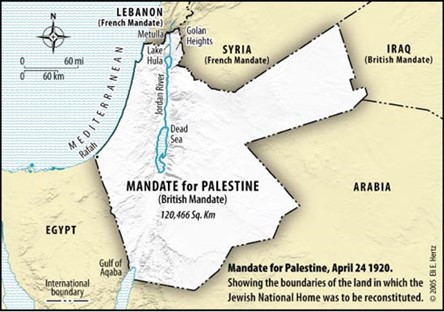
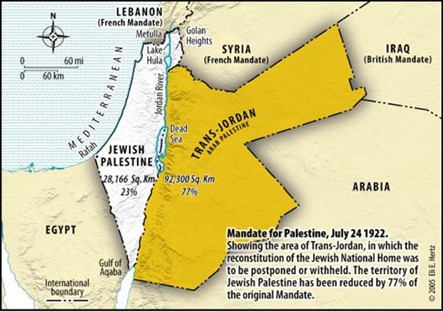
San Remo Conference proposed Jewish Homeland April 24, 1920 League of Nations Mandate (2-State Solution) July 24, 1922
In 1947, the UN recognized that the British Mandate of 1922 was ineffective, leading to a second 2-state solution called the Plan of Partition, which again, convolutedly divided the mandated Jewish homeland in half, and designated Jerusalem as an international city, neither Muslim nor Jewish (1st map below). One year later, a day after Israel declared Statehood, five surrounding Muslim countries attacked Israel, to take the Israeli territories of the UN-approved Partition Plan. Israel defeated the attacking Muslims, taking back almost half of the territory lost in the Partition plan. Then in 1967, the Muslim countries attacked again, and again Israel was victorious, obtaining the remaining territory lost to the Partition Plan (including Jerusalem), as well as the additional territories of Egypt’s Sinia Peninsula and the Golan heights of southwestern Syria, more than doubling Israel’s border region (maps 2 and 3).
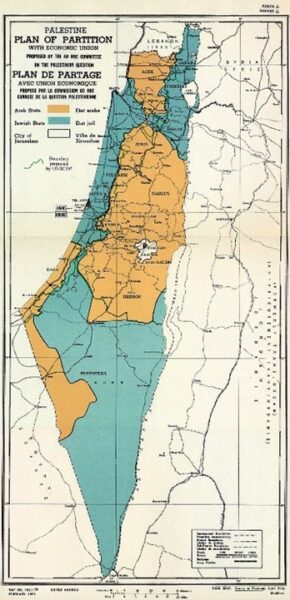
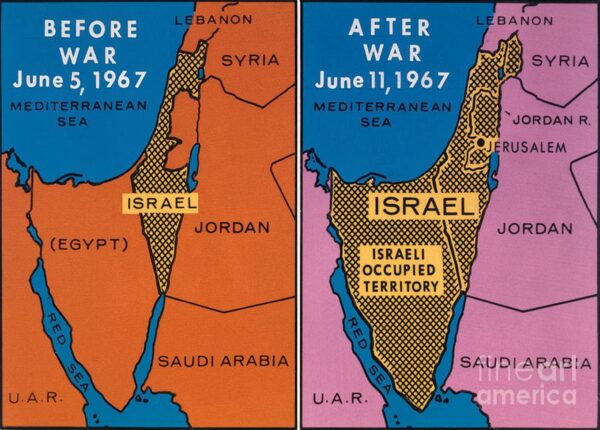
UN 1947 Partition Plan (Israel Green) Before and after the 6-day war against Israel in 1967
In 1979 Israel returned the Sinia Peninsula region to Egypt in exchange for Egypt’s recognition of Israel as an independent state within the remaining border region. The Egypt-Israel Peace Treaty also called for the full autonomy of the Palestinian people presently living within the Israel-recognized territories of Gaza and the West Bank. Full Autonomy means the ability to make your own decisions without being controlled by others, it does not mean you are entitled to the land. If a teenager is given full autonomy in his parent’s home, he is free to make his own decisions, but it does not mean he owns his parents’ home or even his room. For National Security reasons, full autonomy was something Israel could not immediately agree to but would continue to work towards as Israel became more secure (despite continued Muslim threats and aggressions). During the Oslo Accords of 1993 and 1995, Israel agreed to Palestinian self-autonomy within Israel's territories in the hope of peace. The self-autonomy that led to the Hamas leadership and control of the Gaza region, and today’s war with Israel.
Despite all of Israel’s Conciliatory efforts over the past 75 years, Muslims continue their aggressions to eliminate the State of Israel, while successfully chipping away at Western resolve through a propaganda campaign of victimization. But Muslims speak with a forked tongue, claiming land rights based on their aggressive victories during the Islamic Empire conquests, while at the same time dismissing Israeli victor's rights, derived from three more recent Muslim defeats of aggression. Muslim propaganda is based on a simple one-sided twisted logic: To the victor go the spoils, except when you’re not the victor, in which case you become the helpless victim, regardless of your aggression in all cases.
So, what are the facts and fictions which have been repeatedly demonstrated, over the past 100+ years of this region’s history?
Fiction (or Propaganda)
- The Muslims are truly seeking a 2-State Solution. (Two past Western efforts have failed due to Muslim refusal to recognize them)
- Israel is the aggressive occupier of Muslim lands. (Israel's perceived occupation was instituted by the UN, not Israel, after the Muslim WWI loss of land rights)
- The Palestinians have a rightful land claim based on ancient ethnicity. (Palestinians are not an ancient ethnicity, and they were not Philistines ancestors)
Facts
- The Muslims are only truly interested in the complete elimination of the State of Israel.
- All past conciliatory acts by the West and Israel have failed, only to be aggressively violated militarily by the Muslims.
- For Muslims, negotiated peace terms are only a temporary condition, to be viewed as a stepping stone to the more permanent condition of military conquest.
But there is one more Biblical fact that precedes all these recent historical events, which is the most important fact of all. The land in dispute is neither Palestinian, Muslim, nor Jewish land. It is ‘God’s land’ as he declared in Leviticus 25, and God chose his elected people of Israel as the temporary tenant caretakers of his land. In simple terms, God leased his land to the Israelites until his return. As part of God’s lease terms, Israel is not allowed to permanently sell the land, as is normal for any leased property. (Selling includes exchanging the land rights, for terms of peace in return).
Leviticus 25:23 The land shall not be sold permanently, because the land is mine and you reside in my land as foreigners and sojourners (Sojourners means temporary tenants).
In 1920, Britain began the negotiation process of dividing God’s land, so in 1940, God began the reciprocal process of dividing Britain’s Empire into its present nonexistence. This is something Western world leaders, and their people, would be wise to recognize as many seek Israel’s capitulations in their streets and governmental offices. Soon the rightful deed holder of the disputed land will return to lay claim to his estate.
This season let us hope for Middle East peace, but with a truthful understanding, and in accordance with God’s will.
Seasons Greetings and Maranatha,
Gerry S. Sager
gerryssager.com

Welcome, I'm Gerry
Gerry S. Sager, appreciates the depths of Scripture and finding ways to explain its mysteries applicable to end-times prophecies. His favorite Bible passages are Luke 11:9–10, and Proverbs 25:2, which have fostered his Christian growth and efforts to glorify God.
With Love,
Gerry S. Sager
Search the Newsletters
Categories
Archives
New Release
